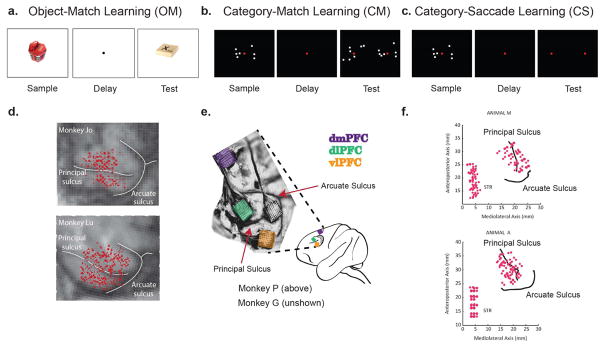Figure 1.
A. In the Object-Match, task the animal was instructed to learn by trial- and error- whether a sample and test object were the correct pair. In each trial, the animal was first presented a sample object for 0.5s, and after a delay of 0.75s, a test object. The animal had to confirm whether the test object was the correct associate of the sample object (i.e. the correct match). In every session, each animal learned to associate 4 different sample objects with 2 test objects (Brincat and Miller, 2015). B, In the Category-Match task, each animal had to learn by trial-and-error two different, de novo dot-pattern categories. In each trial, the animal was first presented with a sample exemplar from one of two possible and, then after a variable delay (.85–1.25s), test exemplars one from each of the two possible categories. In order to select the test exemplar corresponding to the category of the sample, the animal had to fixate on it for .7s. In this task, the animals were matching the category of the sample to the category of the test, hence Category-Match learning. C. In the Category-Saccade task, each animal had to learn two different, de novo categories. In this task, the animal was presented with a sample exemplar for 0.6s, held fixation through a 1s delay, and had to indicate the category membership of this exemplar by making a saccade to the right or left target (Antzoulatos and Miller, 2011). D. In the Object-Match task, we recorded from 617 pairs within prefrontal cortex (PFC) and 941 pairs between PFC and hippocampus (HPC). Electrodes within PFC were spread equally across ventrolateral and dorsolateral prefrontal cortex (vlPFC and dlPFC). E. In the Category-Match task, we recorded from 64 electrode arrays in each vLPFC, dLPFC, and dorsomedial PFC (dmPFC). For PFC, we combined vlPFC and dlPFC electrode pairs, and recorded from 4032 pairs. For PFC-dmPFC, we recorded from 8192 pairs of electrodes. F. In the Category-Saccade task, we recorded from 240 PFC pairs (across both vl- and dlPFC), and 426 PFC-striatal (STR) electrode pairs.

